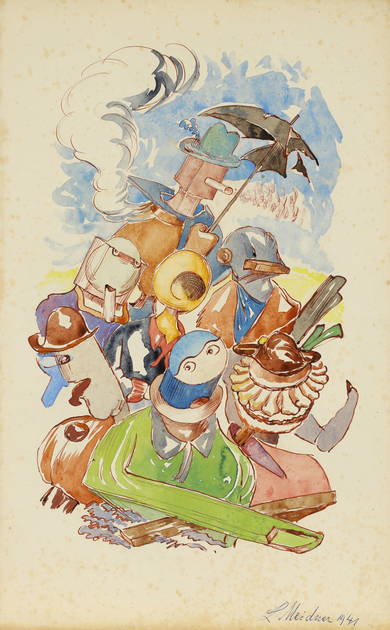Ludwig Meidner - The Humoresque and Grotesque
Ludwig Meidner - The Humoresque and Grotesque
Every five or six weeks, in order to dampen my sense of great and grim earnestness, I paint an amusing, excessively amusing, indeed feckless and cheeky motif in watercolors ...
letter from Ludwig Meidner to Wolf Bergmann dated Oktober 23, 1949, Institut Mathildenhöhe Darmstadt, at Stadtarchiv Darmstadt, ST 45 Meidner Nr. 108
While still in internment Meidner painted watercolors in his sketchbooks featuring both humorous and grotesque motifs. In the course of his English exile these became extensive series, which Meidner grouped under different titles ("Cafés, Theater, Vaudeville", "Allegories", "Nature Mysticism and Fantasies", "Allotria", "Insects and Fairytales" etc.). Although drawing inspiration from the English tradition of caricature and pictorial satire – namely William Hogarth, Thomas Rowlandson and James Gillray – these works are for the most part not caricatures in the narrow sense, since they often have a cryptic, even menacing character: "... they are not in fact simply funny; something has been added to them I have not intended which prevents them appealing to the English beholder: a social aspect, a morbid undertone." (letter from Ludwig Meidner to Wolf Bergmann dated October 23, 1949, Institut Mathildenhöhe Darmstadt, at Stadtarchiv Darmstadt, ST 45 Meidner Nr. 108)
Closer inspection of the figures in the watercolor here reveals several motifs that obviously have a symbolic character but whose meaning remains ambiguous. The tattered umbrella that one of the figures holds over his head can be readily interpreted as a symbol of defenselessness, of the destruction of security or a self-deceiving illusion of security. Other motifs suggest pictorial translations of idioms. For example, the yellow figure in the middle has a hole in its head in place of a face, suggesting the expression "Hohlkopf" (literally "hollow head", meaning dimwit). The fact that there are seven figures could also refer to an allegorical aspect. In fact the structure of the image and the grotesque character of the figures recall "The Seven Deadly Sins" by Otto Dix (1891–1969), although it is highly unlikely that Meidner was familiar with the painting, which Dix produced in 1933. The figure consuming a sausage to the lower left in Meidner's watercolor could certainly be interpreted as a personification of gluttony. However, the references of the remaining figures to the other deadly sins – pride, wrath, lust, sloth, envy and greed – are so vague that an interpretation of the composition as representing the seven deadly sins does not seem mandatory.
Further reading:
Horcher in die Zeit. Ludwig Meidner im Exil (exhibition catalog Museum Giersch der Goethe-Universität, Frankfurt am Main), München 2016, p. 126f.







